The sport of BMX has gained significant popularity since its inception in the 1970s. With dedicated bicycles designed for BMX racing and park riding, beginners now have the opportunity to learn and master basic skills and tricks. Whether you’re a newcomer to BMX or looking to improve your technique, this article will provide valuable insights and tips to help you on your journey to becoming a proficient BMX rider.
Key Takeaways:
- Developing basic skills and tricks is essential for beginners in BMX.
- Mastering the manual and the 180 bunny hop are fundamental tricks for any BMX rider.
- Learning the proper technique for basic jumps is crucial for advancing in BMX riding.
- Choosing the right BMX gear, including a lightweight bike with quality parts, enhances the riding experience.
- BMX freestyle encompasses various disciplines such as dirt, vert, street, and flatland, each offering unique challenges and tricks.
The Manual: Balancing on the Back Wheel
The manual is a fundamental trick for BMX riders, requiring skillful balance and control. It involves keeping the bike balanced on its back wheel without pedaling. To execute a manual, riders must find their balance point by shifting their body weight and counter-balancing with the front of the bike.
Mastering the manual technique takes practice and patience. It’s important to understand the breakpoints in balance and develop a sense of control over the bike. By finding the right equilibrium and maintaining it, riders can execute smooth manuals with finesse.
Tips for Mastering the Manual Technique:
- Find the balance point: Experiment to find the sweet spot where the bike remains balanced on the rear wheel without tipping over backward.
- Counter-balance: Shift your body weight forward, leaning slightly over the handlebars to counteract the weight on the back wheel.
- Control body movements: Use subtle adjustments in body positioning to maintain balance and control over the bike.
- Practice in a controlled environment: Start by practicing the manual technique in an open and flat space until you feel comfortable with the balance and control required.
- Visualize the technique: Watch videos or observe experienced riders to visualize and understand the proper body positions and movements.
By practicing the manual technique regularly, riders can improve their balance, control, and overall bike handling skills. It serves as a foundation for other advanced tricks and maneuvers in the world of BMX riding.
Benefits of Mastering the Manual:
“The manual is not only a show of skill, but it’s also a useful trick for navigating rough terrain, street obstacles, and maintaining control while riding at slow speeds. It enhances bike control, balance, and the rider’s overall riding abilities.”
– Mark Johnson, professional BMX rider and coach
By incorporating the manual into their repertoire, BMX riders can elevate their riding experience, conquer challenging obstacles, and showcase their mastery of bike control.
| Benefits of Manual Technique | Tips for Mastering the Manual |
|---|---|
|
|
Mastering the 180 Bunny Hop
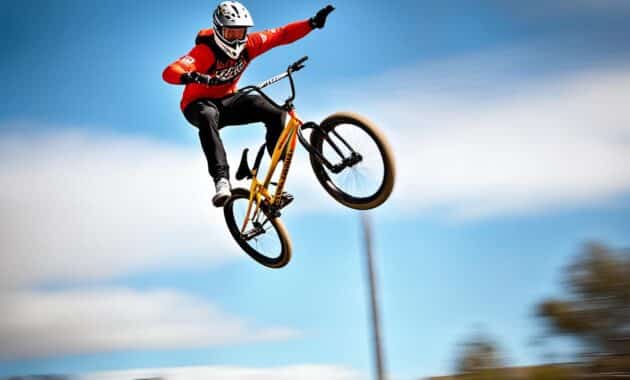
The 180 bunny hop is a basic trick that adds an element of style to the traditional bunny hop. In addition to jumping straight up, the rider incorporates a half spin during the jump, landing in the opposite direction they started. This trick requires riders to rotate their head and shoulders while twisting their body in mid-air. It can be challenging to commit to the spin and trust in the landing, but with practice, it can become a fundamental trick in a BMX rider’s repertoire.
Visualizing the technique is crucial for mastering the 180 bunny hop. Videos provide invaluable guidance, allowing riders to observe the proper execution of the trick. By studying the movement and body positioning of experienced riders, beginners can gain insight into the mechanics of the 180 bunny hop and develop a clear mental image to replicate.
Here are the step-by-step instructions to help you master the 180 bunny hop:
- Start by riding at a moderate speed and maintaining a balanced body position on the bike.
- As you approach the jump, crouch down and compress your body, using your arms and legs to generate upward force.
- While simultaneously jumping straight up, initiate the half spin by rotating your head and shoulders in the direction opposite to where you want to land.
- Twist your body in mid-air, keeping your eyes focused on the landing spot.
- Extend your legs as you approach the landing, ready to absorb the impact.
- Once your wheels touch the ground, maintain your balance and continue riding in the opposite direction.
Remember, mastering the 180 bunny hop takes time and practice. It is essential to start with smaller jumps and gradually increase the height and difficulty as your confidence grows. Don’t be discouraged by initial challenges; instead, stay determined and persistent. With perseverance, you will conquer the 180 bunny hop and unlock a thrilling trick in your BMX repertoire.
Mastering Basic Jumps
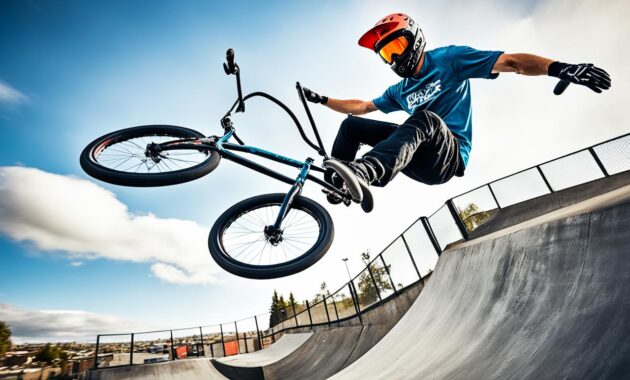
Basic jumps are essential skills for park and freestyle BMX riding. These jumps not only add excitement to your ride but also lay the foundation for more advanced tricks and maneuvers. Building confidence and mastering the basic jump technique is crucial for every BMX rider.
When approaching a jump, one of the key factors is maintaining the right speed. You need enough momentum to launch both yourself and your BMX bike into the air. This momentum will help you achieve the height and distance needed to clear the jump successfully.
As you approach the takeoff, focus on keeping your body positioned correctly to ensure a smooth jump. Push your hands forward to level your body, aligning it with the bike’s frame. This position will help you maintain stability and control during the jump.
When it comes to landing, it’s crucial to avoid pushing the nose of your bike too far down. If you push too hard, you risk flipping over the handlebars, potentially leading to an accident. Instead, aim to land with your bike parallel to the landing surface, ensuring a safe and controlled touchdown.
For beginners, it’s advisable to start with smaller jumps and gradually increase the difficulty as your skills progress. This approach allows you to build confidence and develop a solid foundation in basic jump techniques.
Benefits of Mastering Basic Jumps:
- Enhanced bike control and maneuverability
- Increased balance and stability
- Ability to tackle more advanced tricks and obstacles
- Improved overall riding confidence
Remember, practice is key when it comes to mastering basic jumps. The more you practice, the more comfortable and skilled you’ll become in executing jumps with precision. Consider watching instructional videos or enlisting the guidance of experienced riders to improve your technique and progress further in your BMX journey.
By dedicating time and effort to mastering basic jumps, you’ll develop the necessary skills and confidence to take your BMX riding to new heights.
Choosing the Right BMX Gear
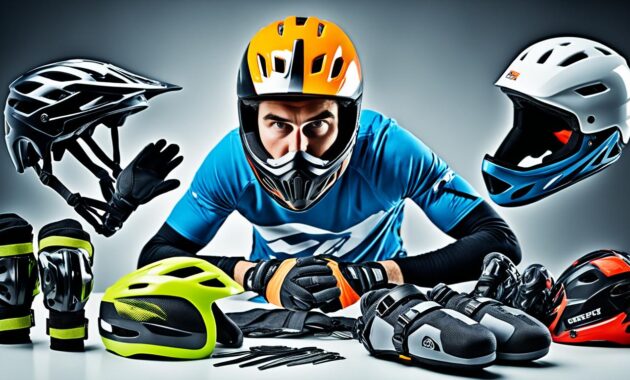
When it comes to BMX riding, having the right gear is essential for both performance and safety. The modern BMX bikes available today are designed with lightweight frames and high-quality components, making them far superior to the heavier bikes of the past. Brands like SE Bikes and GT have established themselves as leaders in the industry, offering a wide range of BMX bikes with innovative features and superior construction.
One important consideration when choosing a BMX bike is finding the right frame size that fits your body and riding style. A properly sized bike ensures optimal comfort and control, allowing you to perform at your best. You’ll also want to look for bikes with quality parts such as removable brake hardware, sealed hubs, and high-quality crank sets, as these components significantly impact the bike’s durability and overall performance.
Investing in a durable and well-built BMX bike with the right specifications can greatly enhance your riding experience. Whether you’re a beginner or an experienced rider, having reliable gear allows you to push your limits and explore new possibilities. Plus, choosing a bike from trusted brands ensures that you’re getting a product that has been tested and approved by professionals.
Remember, BMX riding is not just about the bike itself but also the safety gear you wear. Investing in a high-quality helmet, knee pads, and elbow pads is crucial to protect yourself from potential injuries. Safety should always be a priority, especially when attempting more advanced tricks and maneuvers.
| Brand | Features |
|---|---|
| SE Bikes | Removable brake hardware, sealed hubs, high-quality crank sets |
| GT | Lightweight frames, durable components, cutting-edge designs |
Finding the right BMX gear may require some research and experimentation, but the rewards are well worth it. With the right bike and gear, you’ll be able to tackle any obstacle and take your BMX skills to new heights. So, make sure to choose wisely and gear up for an exhilarating ride!
The First Three Essential BMX Tricks
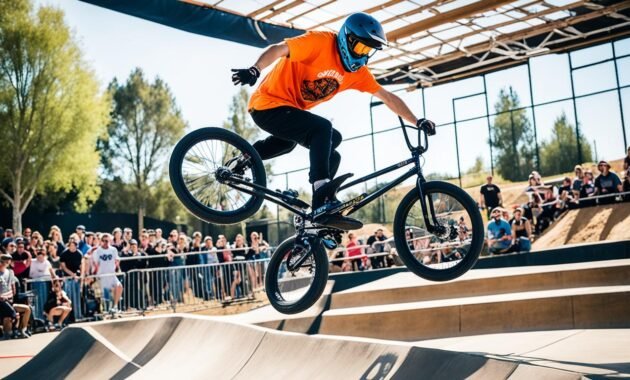
When it comes to BMX riding, mastering a few essential tricks can lay the foundation for your progression in the sport. Experts suggest that beginners focus on three fundamental tricks: the bunny hop, the manual, and the fakie. These tricks not only enhance your bike control but also build your awareness and strength on the BMX bike.
The Bunny Hop
The bunny hop is a fundamental trick that every BMX rider should learn. It involves jumping the bike into the air by pulling up the front wheel. This trick is the basis for many other advanced moves and allows you to clear obstacles like curbs and ramps. To perform a bunny hop, crouch down and then explode upward, pulling the handlebars toward your chest while lifting your feet. Practice timing and coordination to achieve the perfect bunny hop every time.
The Manual
The manual is a skill that requires balance and control. In a manual, you balance on the back wheel of the BMX bike without pedaling. To perform a manual, shift your weight to the rear while keeping your arms straight and your body centered over the bike. Practice finding the balance point and adjusting your body positioning to maintain the manual for an extended period. This trick will improve your overall bike control and help you navigate various obstacles with ease.
The Fakie
Mastering the fakie technique allows you to ride your BMX bike backward, opening up a world of possibilities for tricks and maneuvers. To perform a fakie, ride forward, and then shift your weight, leaning back slightly, while pedaling backward. Start with small distances and gradually increase your fakie skills as you gain confidence and control. This trick not only adds style to your riding but also enhances your spatial awareness and coordination.
The bunny hop, the manual, and the fakie form the essential trio of tricks every BMX beginner should learn. These tricks serve as building blocks for more advanced moves and lay the groundwork for your progression in the sport. Practice these tricks consistently, and you’ll soon find yourself ready to take on new challenges and push the boundaries of your BMX riding.
Exploring Different Types of BMX Freestyle

BMX freestyle offers a thrilling array of disciplines, each with its own specialized tricks and unique environments. Whether you prefer soaring through the air on dirt ramps or conquering urban obstacles, there’s a BMX discipline to suit every rider’s style and preference. Let’s take a closer look at the different types of BMX freestyle:
Dirt Discipline: Jumping Over Hills and Ramps
The dirt discipline of BMX freestyle revolves around jumping over hills or dirt ramps. Riders showcase their skills and style by launching themselves into the air, performing gravity-defying tricks, and landing with precision. This high-energy discipline is often associated with outdoor parks or trails and requires a mix of speed, control, and aerial finesse.
Vert Discipline: Mastering Tricks on Half Pipes
The vert discipline focuses on performing tricks on half pipes, which are U-shaped ramps. Riders gain momentum on the curved ramp, launch themselves into the air, and execute awe-inspiring aerial maneuvers. This discipline requires exceptional balance, spatial awareness, and the courage to push the limits of gravity.
Street Riding: Conquering Urban Obstacles
Street riding involves conquering a variety of obstacles in urban environments, such as rails, curbs, stairs, and walls. Riders showcase their creativity by incorporating these elements into their tricks, combining technical skills and style. Street riding is all about adapting to the urban landscape, finding unique lines, and pushing the boundaries of what’s possible in an urban setting.
Flatland: Balancing and Creating on a Level Surface
Flatland is a discipline in which tricks are performed on a flat surface, often in a stationary or slow-moving manner. The focus of flatland riding is on balance, control, and creative expression. Riders master intricate spins, flips, and body positions while keeping their bikes in constant motion. This unique discipline highlights the artistic side of BMX freestyle.
Exploring and mastering these different disciplines not only adds variety and excitement to a rider’s BMX experience but also broadens their skill set. Each discipline presents its own challenges and rewards, allowing riders to push their limits and carve their own path in the world of BMX freestyle.
BMX Tricks for Beginners
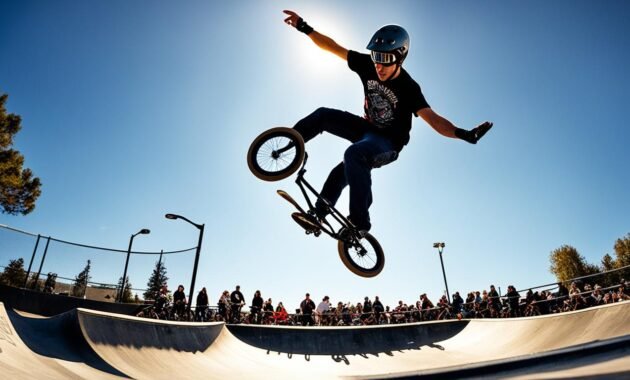
If you’re a beginner looking to up your BMX game, handlebar tricks are a great place to start. These tricks not only enhance your bike control but also provide a solid foundation for more complex maneuvers. Let’s dive into three beginner-friendly handlebar tricks that will take your BMX skills to the next level.
The X-up
The X-up is a stylish trick that involves rotating the handlebars 180 degrees, forming an “X” with your arms. To execute this trick, start by popping off the ground and using your wrists and arms to twist the bars. Practice the motion until you can smoothly rotate the handlebars without losing control. The X-up adds flair to your riding and is a great way to impress your friends at the skate park.
The Barspin
The barspin is another handlebar trick that requires mid-air finesse. Begin by jumping off a ramp or launching yourself into the air. As you reach the peak of your jump, use your hands to push the handlebars in a spinning motion while releasing them momentarily. Start with a half turn barspin and gradually work your way up to more advanced spins, like the 540-degree barspin. The barspin adds style and creativity to your BMX repertoire.
The Hang Five
The hang five is a trick that focuses on your balance and control. To perform this stunt, lift your rear wheel off the ground and balance on your front peg. This trick requires a lot of practice and core strength. Start by finding a flat area where you can balance comfortably. As you gain confidence, experiment with different body positions and movements to add a personal touch. The hang five is a challenging but rewarding trick that will improve your overall bike control.
Remember, practicing these tricks takes time and dedication. Start with the X-up, barspin, and hang five, and gradually progress as you build your skills. Don’t forget to wear appropriate safety gear and always ride within your skill level. Now, grab your BMX bike and start mastering these beginner-friendly handlebar tricks!
Browse the table below for a quick reference on the BMX tricks discussed in this section:
| Trick | Description |
|---|---|
| X-up | Rotate the handlebars 180 degrees, forming an “X” with your arms. |
| Barspin | Push the handlebars in mid-air to initiate a spinning motion. |
| Hang Five | Balance on your front peg with the rear wheel lifted off the ground. |
Mastering BMX Basics for Tricks and Feats

Mastering the basics is essential for executing advanced BMX tricks and feats. By developing a strong foundation in fundamental skills, riders can progress to more complex and impressive maneuvers. Let’s explore some of the key elements in learning BMX tricks.
Bunny Hop: Jumping Over Obstacles
The bunny hop is one of the most important BMX tricks for beginners. It allows riders to jump over obstacles like curbs, ramps, or even other riders. To perform a bunny hop, the rider needs to generate upward force by pulling up on the handlebars while simultaneously compressing the bike’s suspension and legs. It requires coordination and timing to land smoothly and maintain control.
Grinds and Lip Tricks: Mastering Railings and Curbs
Grinds and lip tricks are commonly seen in BMX park and street riding. They involve sliding or balancing on railings, curbs, ledges, or any other surface riders can find. Performing a grind or lip trick requires precise control and balance. It’s important to approach the obstacle at the right angle and apply the appropriate force to maintain stability and control throughout the trick.
“Grinds and lip tricks are a test of a BMX rider’s skill and creativity. The way you approach and execute these tricks can set you apart from others.” – Professional BMX Rider
Flatland Tricks: Showcasing Balance and Creativity
Flatland is a discipline of BMX riding that focuses on performing tricks on a flat surface. It requires excellent balance, creativity, and precise bike control. Flatland tricks often involve intricate body movements, spins, and combinations of various bike maneuvers. Riders can create their own unique routines and showcase their individual style and skills.
BMX Basics for Tricks and Feats
| Trick | Description |
|---|---|
| Bunny Hop | Jumping technique to clear obstacles |
| Grind | Sliding or balancing on railings and curbs |
| Lip Trick | Performing tricks on the edge of obstacles |
| Flatland | Tricks and maneuvers on a flat surface |
By mastering these foundational skills and tricks, BMX riders can unlock their full potential and take their riding to the next level. Remember, practice, perseverance, and a passion for BMX are key to achieving mastery in these tricks and feats.
Also Read : Transition Bikes: Superior MTB Performance
Conclusion
Mastering BMX skills and tricks is a journey that requires time, practice, and dedication. Starting with the basics, such as manuals, bunny hops, and basic jumps, lays a strong foundation for progression in the sport.
Another crucial aspect of BMX progression is choosing the right gear. Opting for a lightweight and maneuverable BMX bike with quality components can greatly enhance the riding experience, allowing riders to push their limits and explore new tricks and techniques.
By venturing into different disciplines and trying out various tricks, such as handlebar tricks and terrain-specific maneuvers, BMX riders can add excitement and variety to their journey. These experiences ignite a sense of progression and create opportunities to unlock new skills.
With continuous improvement and dedication, BMX riders can unlock their full potential and enjoy the true thrill of this dynamic and exhilarating sport. Through constant learning, practice, and pushing boundaries, the possibilities for BMX progression are endless.
FAQs
Q: What is a BMX bike?
A: A BMX bike is a type of small, agile, and lightweight bicycle designed for racing, stunts, and tricks.
Q: Where can I find a good source for BMX bikes and accessories?
A: You can check out BMX stores or online websites like Source BMX for a wide range of BMX bikes and parts.
Q: What are some popular BMX brands known for quality bikes?
A: SE Bikes, GT, and Flyer Seat are popular BMX brands known for their quality bikes and accessories.
Q: What is the significance of the handlebar on a BMX bike?
A: The handlebar on a BMX bike is essential for steering and balance, providing control while performing tricks and maneuvers.
Q: What size wheel is commonly used in BMX bikes?
A: Wheel sizes like 20.75, 20.5, and larger wheels are commonly used in BMX bikes for different riding styles and preferences.
Q: What are some key features to look for in a beginner BMX bike?
A: When choosing a beginner BMX bike, look for features like lightweight construction, quality parts like Odyssey Springfield brakes, and easy maneuverability.
Q: How can I start learning to do wheelies on a BMX bike?
A: To learn how to do wheelies on a BMX bike, practice balancing on the rear wheel while pedaling smoothly and maintaining control over the handlebars.
Q: Why are BMX bikes popular for use in skateparks?
A: BMX bikes are popular in skateparks due to their maneuverability, durability, and ability to perform tricks and stunts on various ramps and obstacles.
Q: What are some popular BMX brands for beginners?
A: Some popular BMX brands for beginners include SE Bikes, GT, and Big Wheel BMX Bike.
Q: Where can I buy BMX bikes and accessories?
A: You can buy BMX bikes and accessories at BMX stores or online from sources like BMX store websites.
Q: What size BMX bike should a beginner choose?
A: For beginners, a BMX bike with a wheel size around 20.5 to 20.75 inches is recommended.
Q: What are some key features to look for in a beginner BMX bike?
A: Key features to look for in a beginner BMX bike include a sturdy frame, quality parts like Odyssey Springfield brakes, and a comfortable seat like Flyer Seat.
Q: Can a beginner perform tricks on a BMX bike?
A: Yes, beginners can start learning and practicing basic tricks and maneuvers at a skatepark or in open areas with their BMX bikes.
Q: How can a beginner improve their BMX skills?
A: Beginners can improve their BMX skills by practicing regularly, watching tutorials, and seeking guidance from experienced riders.
Q: What is the importance of a proper pedal on a BMX bike?
A: Having the right pedal on a BMX bike can enhance grip and control while riding, making it essential for beginners to choose suitable pedals.
Source Links
- http://www.donsbmx.com/2017/12/bmx-tricks-you-can-master.html
- https://dougsterbob.com/2022/08/06/first-3-tricks-to-learn-on-bmx-most-important/
- https://ottawabmx.com/bmx-tricks-tips-on-tricks-on-the-bike/
